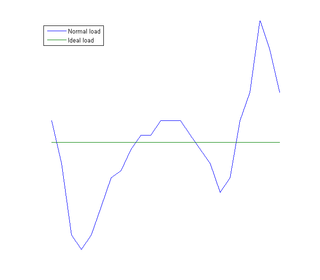In a broad sense, an electricity market is a system that facilitates the exchange of electricity-related goods and services. During more than a century of evolution of the electric power industry, the economics of the electricity markets had undergone enormous changes for reasons ranging from the technological advances on supply and demand sides to politics and ideology. A restructuring of electric power industry at the turn of the 21st century involved replacing the vertically integrated and tightly regulated "traditional" electricity market with multiple competitive markets for electricity generation, transmission, distribution, and retailing. The traditional and competitive market approaches loosely correspond to two visions of industry: the deregulation was transforming electricity from a public service into a tradable good. As of 2020s, the traditional markets are still common in some regions, including large parts of the United States and Canada.
Distributed generation, also distributed energy, on-site generation (OSG), or district/decentralized energy, is electrical generation and storage performed by a variety of small, grid-connected or distribution system-connected devices referred to as distributed energy resources (DER).

The utility frequency, (power) line frequency or mains frequency is the nominal frequency of the oscillations of alternating current (AC) in a wide area synchronous grid transmitted from a power station to the end-user. In large parts of the world this is 50 Hz, although in the Americas and parts of Asia it is typically 60 Hz. Current usage by country or region is given in the list of mains electricity by country.

The National Grid is the high-voltage electric power transmission network serving Great Britain, connecting power stations and major substations, and ensuring that electricity generated anywhere on the grid can be used to satisfy demand elsewhere. The network serves the majority of Great Britain and some of the surrounding islands. It does not cover Northern Ireland, which is part of the Irish single electricity market.
The National Electricity Market (NEM) is an arrangement in Australia's electricity sector for the connection of the electricity transmission grids of the eastern and southern Australia states and territories to create a cross-state wholesale electricity market. The Australian Energy Market Commission develops and maintains the Australian National Electricity Rules (NER), which have the force of law in the states and territories participating in NEM. The Rules are enforced by the Australian Energy Regulator. The day-to-day management of NEM is performed by the Australian Energy Market Operator.

The Electric Reliability Council of Texas, Inc. (ERCOT) is an American organization that operates Texas's electrical grid, the Texas Interconnection, which supplies power to more than 25 million Texas customers and represents 90 percent of the state's electric load. ERCOT is the first independent system operator (ISO) in the United States. ERCOT works with the Texas Reliability Entity (TRE), one of eight regional entities within the North American Electric Reliability Corporation (NERC) that coordinate to improve reliability of the bulk power grid.

Demand response is a change in the power consumption of an electric utility customer to better match the demand for power with the supply. Until the 21st century decrease in the cost of pumped storage and batteries electric energy could not be easily stored, so utilities have traditionally matched demand and supply by throttling the production rate of their power plants, taking generating units on or off line, or importing power from other utilities. There are limits to what can be achieved on the supply side, because some generating units can take a long time to come up to full power, some units may be very expensive to operate, and demand can at times be greater than the capacity of all the available power plants put together. Demand response, a type of energy demand management, seeks to adjust in real-time the demand for power instead of adjusting the supply.

The Texas Interconnection is an alternating current (AC) power grid – a wide area synchronous grid – that covers most of the state of Texas. The grid is managed by the Electric Reliability Council of Texas (ERCOT).
A virtual power plant (VPP) is a cloud-based distributed power plant that aggregates the capacities of heterogeneous distributed energy resources (DER) for the purposes of enhancing power generation, trading or selling power on the electricity market, and demand side options for load reduction.
To balance the supply and demand of electricity on short timescales, the UK National Grid has contracts in place with generators and large energy users to provide temporary extra power, or reduction in demand. These reserve services are needed if a power station fails for example, or if forecast demand differs from actual demand. National Grid has several classes of reserve services, which in descending order of response time are: Balancing Mechanism (BM) Start-Up, Short-Term Operating Reserve, Demand Management and Fast Reserve.

Load management, also known as demand-side management (DSM), is the process of balancing the supply of electricity on the network with the electrical load by adjusting or controlling the load rather than the power station output. This can be achieved by direct intervention of the utility in real time, by the use of frequency sensitive relays triggering the circuit breakers, by time clocks, or by using special tariffs to influence consumer behavior. Load management allows utilities to reduce demand for electricity during peak usage times, which can, in turn, reduce costs by eliminating the need for peaking power plants. In addition, some peaking power plants can take more than an hour to bring on-line which makes load management even more critical should a plant go off-line unexpectedly for example. Load management can also help reduce harmful emissions, since peaking plants or backup generators are often dirtier and less efficient than base load power plants. New load-management technologies are constantly under development — both by private industry and public entities.

Availability Based Tariff (ABT) is a frequency based pricing mechanism applicable in India for unscheduled electric power transactions. The ABT falls under electricity market mechanisms to charge and regulate power to achieve short term and long term network stability as well as incentives and dis-incentives to grid participants against deviations in committed supplies as the case may be.

An electrical grid is an interconnected network for electricity delivery from producers to consumers. Electrical grids vary in size and can cover whole countries or continents. It consists of:
Ancillary services are the services necessary to support the transmission of electric power from generators to consumers given the obligations of control areas and transmission utilities within those control areas to maintain reliable operations of the interconnected transmission system.
Inertial response is a property of large synchronous generators, which contain large synchronous rotating masses, and which acts to overcome any immediate imbalance between power supply and demand for electric power systems, typically the electrical grid. Due to the ever existing power imbalance between mechanical power supply and electric power demand the rotational frequency of the rotating masses in all synchronous generators in the grid either speed up and thus absorb the extra power in case of an excess power supply, or slow down and provide additional power in case of an excess power demand. This response in case of a synchronous generator is built-in into the design and happens without any external intervention or coordination, providing the automatic generation control and the grid operator with valuable time to rebalance the system The grid frequency is the combined result of the detailed motions of all individual synchronous rotors in the grid, which are modeled by a general equation of motion called the swing equation.
Grid balancing ensures that electricity consumption matches electricity production of an electrical grid at any moment. Electricity is by its nature difficult to store and has to be available on demand, so the supply shall match the demand very closely at any time despite the continuous variations of both. In a deregulated grid, a transmission system operator is responsible for the balancing. In a wide area synchronous grid the short-term balancing is coupled with frequency control: as long as the balance is maintained, the frequency stays constant, whenever a small mismatch between aggregate demand and aggregate supply occurs, it is restored due to both supply and demand being frequency-sensitive: lower frequency increases the supply, and higher frequency increases the demand.

The electrical power grid that powers Northern America is not a single grid, but is instead divided into multiple wide area synchronous grids. The Eastern Interconnection and the Western Interconnection are the largest. Three other regions include the Texas Interconnection, the Quebec Interconnection, and the Alaska Interconnection. Each region delivers power at a nominal 60 Hz frequency. The regions are not usually directly connected or synchronized to each other, but there exist some HVDC interconnectors. The Eastern and Western grids are connected with 1.32 GW.
Wreck Cove is the largest hydroelectric system in Nova Scotia with a generating capacity of 215.8 MW. Constructed from 1975 to 1978, south of the Cape Breton Highlands National Park, Wreck Cove collects drainage water from 216 square kilometres (83 sq mi) of the Cape Breton Highlands plateau to generate renewable electricity. It consists of two generating stations: the Gisborne Generating Station, with an installed capacity of 3.5 MW, and the Wreck Cove Generating Station, with an installed capacity of 212 MW, producing on average 318 GWh annually—enough energy to power about 30,000 homes.
A balancing authority (BA) is an entity in the US electric system that is responsible for grid balancing: resource planning and unit commitment ahead of time, maintenance of the load-interchange-generation balance within a balancing authority area and support for real-time load-frequency control. The balancing authorities are connected by metered high-voltage tie lines and grouped into interconnections:
Resource adequacy in the field of electric power is the ability of the electric grid to satisfy the end-user power demand at any time. RA is a component of the electric system reliability. For example, sufficient unused generation capacity shall be available to the electrical grid at any time to accommodate equipment failures and drops in variable renewable energy sources. The adequacy standard should satisfy the chosen reliability index, typically the loss of load expectation (LOLE) of 1 day in 10 years.







